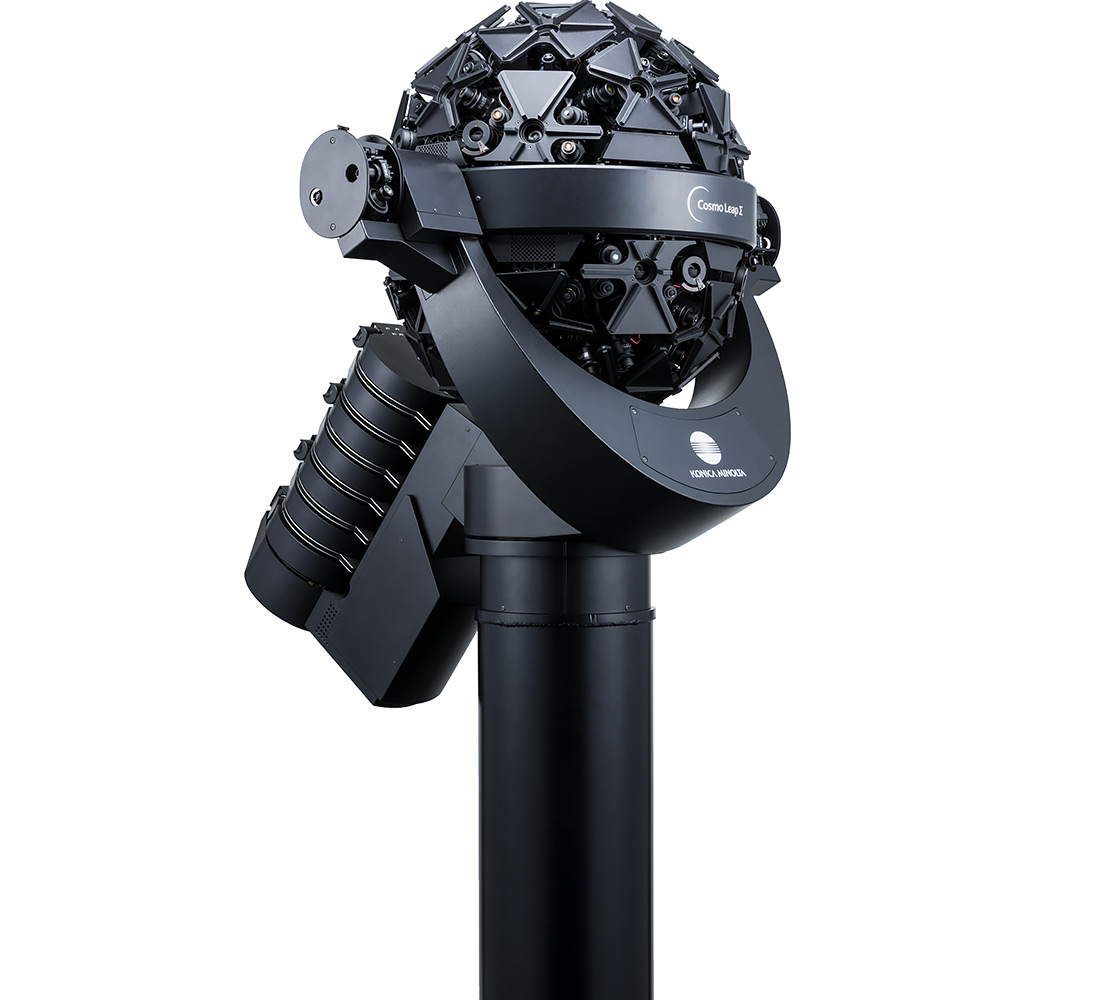
Cosmo Leap Σ
The Cosmo Leap Σ can project the starry sky equivalent to those of the Infinium Σ (Konica Minolta’s flagship optical planetarium that was developed to project beautiful fixed stars shining in the dark night sky) in small and medium-sized domes with an energy-efficient compact design.
Japan is the second most planetarium installed country after the United States of America. It has over 300 facilities and 75% of them are installed by governing bodies, mostly in medium-sized domes ranging approximately 10m in diameter.
In these small and medium-sized domes, Cosmo Leap Σ achieves sharp stellar images with various constellation images and realistic projections of variable stars (i.e., features suitable for giving a detailed narrative of the starry sky) and impresses the audience by projecting a beautiful night sky embellished with glittering stars.

Meaning of Cosmo Leap
“Cosmo Leap” is named it after a quote by Neil Armstrong, commander of Apollo 11.
“That's one small step for a man, one giant leap for mankind.”
2018 Good Design Gold Award winner
「The Cosmo Leap Σ was selected as one of the Good Design Best 100 products out of 4,789 products and services that were subject to screening. It then won a Good Design Gold Award, which is presented to the outstanding designs selected from the 100 best products. The Cosmo Leap Σ is designed to blend harmoniously with cosmic space, representing the company’s wish to arouse children’s creativity and spirit of inquiry.
Features of the Design
With its compact structure incorporating optical technology, the product is designed to blend harmoniously with cosmic space.
Comments from Screening Committee of JDP
While most products cover their structures with some materials, the planetarium is exposed. Its mechanical appearance, made of optical and precision components, appeals to people, especially children. Since the moving parts of the star ball and planet projector follow the movement of the night sky (movement of the Earth), the orderly structure of this precision machine makes children aware that cosmic space is also regularly structured. This aspect of the product was also highly regarded by the jury.
See here for the Good Design Award website

62 Constellation Images, 5 Constellation Lines, 13 Additional Markers (Total of 80 objects)
Spring 11 constellations
| Constellation | IAU |
|---|---|
| Boötes | Boo |
| Hydra | Hya |
| Ursa Major | UMa |
| Virgo | Vir |
| Cancer | Cnc |
| Coma Berenices | Com |
| Corvus | Crv |
| Corona Borealis | CrB |
| Ursa Minor | UMi |
| Leo | Leo |
| Canes Venatici | CVn |
Summer 8 constellations
| Constellation | IAU |
|---|---|
| Sagittarius | Sgr |
| Lyra | Lyr |
| Scorpius | Sco |
| Libra | Lib |
| Cygnus | Cyg |
| Hercules | Her |
| Draco | Dra |
| Aquila | Aql |
5 constellation Lines
| Constellation Lines |
|---|
| Cassiopeia |
| Corvus |
| Crux |
| Orion |
| Scorpius |
13 Additional Markers
| Additional Marker |
|---|
| Big Dipper (Ursa Major) |
| False Cross (Carina and Vela) |
| Great Square of Pegasus |
| Teapot (Sagittarius) |
| Northern Cross (Cygnus) |
| Sickle (Leo) |
| Spring Triangle |
| Spring Semi-circle |
| Summer Triangle |
| Water Jar (Aquarius) |
| Winter Triangle |
| Direction to the North Star (by Big Dipper) |
| Direction to the North Star (by Cassiopeia) |
Autumn 11 constellations
| Constellation | IAU |
|---|---|
| Andromeda | And |
| Pisces | Psc |
| Aries | Ari |
| Cassiopeia | Cas |
| Cetus | Cet |
| Cepheus | Cep |
| Pegasus | Peg |
| Perseus | Per |
| Aquarius | Aqr |
| Piscis Austrinus | PsA |
| Capricornus | Cap |
Winter 7 constellations
| Constellation | IAU |
|---|---|
| Eridanus | Eri |
| Taurus | Tau |
| Canis Major | CMa |
| Orion | Ori |
| Auriga | Aur |
| Canis Minor | CMi |
| Gemini | Gem |
Southern Hemisphere 2 constellations
| Constellation | IAU |
|---|---|
| Grus | Gru |
| Crux | Cru |
Simultaneous Constellation Images 8 types 23 constellations
| Constellation | IAU |
|---|---|
| Lupus | Lup |
| Centaurus | Cen |
| Crater | Crt |
| Sextans | Sex |
| Delphinus | Del |
| Sagitta | Sge |
| Vulpecula | Vul |
| Serpens | Ser |
| Ophiuchus | Oph |
| Sculptor | Scl |
| Phoenix | Phe |
| Indus | Ind |
| Tucana | Tuc |
| Dorado | Dor |
| Reticulum | Ret |
| Horologium | Hor |
| Caelum | Cae |
| Puppis | Pup |
| Vela | Vel |
| Pyxis | Pyx |
| Carina | Car |
| Scutum | Sct |
| Corona Australis | CrA |
Total constellation images:62

